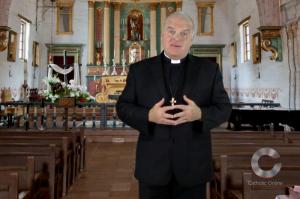We ask you, urgently: don't scroll past this
Dear readers, Catholic Online was de-platformed by Shopify for our pro-life beliefs. They shut down our Catholic Online, Catholic Online School, Prayer Candles, and Catholic Online Learning Resources essential faith tools serving over 1.4 million students and millions of families worldwide. Our founders, now in their 70's, just gave their entire life savings to protect this mission. But fewer than 2% of readers donate. If everyone gave just $5, the cost of a coffee, we could rebuild stronger and keep Catholic education free for all. Stand with us in faith. Thank you.Help Now >
Peba Indians
FREE Catholic Classes
(Or Peva )
The principal of a small group of cognate tribes, comprising the Peba proper, Caumari, Cauhuachi, Pacaya, and Yagua (Zava by error in Chantre y Herrera), together constituting the Peba linguistic stock, and formerly occupying the country about the confluence of the Javarí with the Amazon, in territory held by Peru, but in part claimed also by Ecuador and Columbia. In their primitive condition they resembled the neighbouring Jivaro and Pano, though of less fierce and warlike temper. They held a close friendship with the powerful Amagua of Southern Columbia, and in the eighteenth century formed an important element in the celebrated Jesuit missions of the "Mainas province" of the upper Amazon region. In 1735 (or 1736) the Jesuit Father Singler of the Omagua mission with a few Indian companions reached the main mission of the Caumari and later that of the Peba, who received him with good will and presented him with their most precious gifts, viz. jars filled with the deadly curari poison used by the hunters for tipping their blowgun arrows. They allowed him to set up a cross in the village and listened with respect to his teaching. Some of both tribes accompanied him to the Amagua mission of San Jauquin, but, their health suffering, they were soon brought back and established in a separate mission called San Ignacio de Pebas, which was placed in charge of Father Adan Vidman. Some of the kindred Cauhuachi (Covachi), formerly attached to another Amagua mission, were also brought to San Ignacio, as were later the Yagua. Although nearly related, the tribes differed greatly in temperament. The Peba, according to Fr. Chantre y Herrera, were active and vigorous but rough in manner; the Cauhuachi were equally rude, but more industrious; the Caumari were the neatest and most intelligent; while the Yagua were of restless habit.
In 1754, tribal dissensions resulted in the murder of the resident missionary, Fr. José Casado, by two brothers of the Caumari tribe, resulting in the temporary desertion of the mission of all but the Peba. Fr. José de Vahamonde, a veteran of seventeen years' service in the Amazon forests, was sent to restore order, and under his kindly promises and treatment the fugitives returned and the mission doubled its former number. In spite of smallpox, other disease visitations, and the raids of the Portuguese slave hunters from Brazil, the mission of San Ignacio de Pebas held its rank until the expulsion of the Jesuits in 1768. It then stood fifth in the list of 33 missions in the Mainas province with 700 souls, Father Vahamonde still being in charge. Others of the same tribal group were at the mission of San Ignacio de Mainas, and possibly at other missions. On account of the great diversity of dialects the missionaries had introduced the Quichua language of Peru as the common medium of communication. After the expulsion of the Jesuits the missions were continued under Franciscan auspices with some success. When Peru became a separate government in 1821, the missions were neg;ected and fell into decay. The mission Indians, who had steadily dwindled in number, became scattered, and either lost their identity in the mixed population or joined their still wild forest kindred. The small town of Pebas, on the Amazon, now occupies the site of the old mission. The former tribes are extinct or assimilated, with the exception of a remnant of the Yagua, noted for their fine physique, some of whom are about Pebas and the Napo while others dwell on the lower Javari. The greater portion of their tribe was destroyed by smallpox in 1877.
(See also JÎBARO INDIANS; MAINA INDIANS; MAMELUCO; PANO INDIANS.)
Join the Movement
When you sign up below, you don't just join an email list - you're joining an entire movement for Free world class Catholic education.

Novena for Pope Francis | FREE PDF Download
-

- Stations of the Cross
- Easter / Lent
- 5 Lenten Prayers
- Ash Wednesday
- Living Lent
- 7 Morning Prayers
- Mysteries of the Rosary
- Litany of the Bl. Virgin Mary
- Popular Saints
- Popular Prayers
- Female Saints
- Saint Feast Days by Month
- Pray the Rosary
JUDGES, GUNS, AND GANGS: Cartels Are Infiltrating America’s Cities and Courtrooms
List of 21 California Missions and Founding Dates
Exploring the California Missions and Their Legacy
Daily Catholic
 Daily Readings for Sunday, April 27, 2025
Daily Readings for Sunday, April 27, 2025 St. Zita: Saint of the Day for Sunday, April 27, 2025
St. Zita: Saint of the Day for Sunday, April 27, 2025 Prayer for the Dead # 2: Prayer of the Day for Sunday, April 27, 2025
Prayer for the Dead # 2: Prayer of the Day for Sunday, April 27, 2025 Daily Readings for Saturday, April 26, 2025
Daily Readings for Saturday, April 26, 2025 St. Cletus: Saint of the Day for Saturday, April 26, 2025
St. Cletus: Saint of the Day for Saturday, April 26, 2025- Prayer before the Closing of the Day: Prayer of the Day for Saturday, April 26, 2025
![]()
Copyright 2025 Catholic Online. All materials contained on this site, whether written, audible or visual are the exclusive property of Catholic Online and are protected under U.S. and International copyright laws, © Copyright 2025 Catholic Online. Any unauthorized use, without prior written consent of Catholic Online is strictly forbidden and prohibited.
Catholic Online is a Project of Your Catholic Voice Foundation, a Not-for-Profit Corporation. Your Catholic Voice Foundation has been granted a recognition of tax exemption under Section 501(c)(3) of the Internal Revenue Code. Federal Tax Identification Number: 81-0596847. Your gift is tax-deductible as allowed by law.


 Daily Readings for Sunday, April 27, 2025
Daily Readings for Sunday, April 27, 2025 St. Zita: Saint of the Day for Sunday, April 27, 2025
St. Zita: Saint of the Day for Sunday, April 27, 2025 Prayer for the Dead # 2: Prayer of the Day for Sunday, April 27, 2025
Prayer for the Dead # 2: Prayer of the Day for Sunday, April 27, 2025 St. Cletus: Saint of the Day for Saturday, April 26, 2025
St. Cletus: Saint of the Day for Saturday, April 26, 2025

